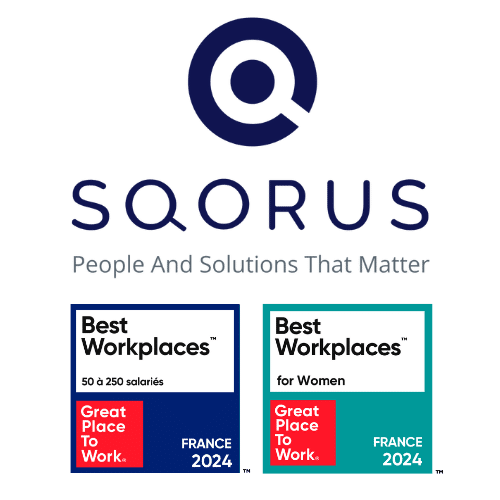In an economic context strongly marked by the digitalization of activities, human resources departments are also impacted by innovative technologies in their HR strategy. But digital transformation is only one of the issues facing HR departments today, and it is made up of both recurring topics (regulatory compliance, salaries, working conditions, diversification, professional equality, career management, recruitment, etc.) and new topics (withholding tax, CSR, employer brand, social networks, data security, etc.).
The digital transformation of the company, inevitable and beneficial
Far from impacting only the IT, R&D or production departments, the digital transition concerns the entire company. It is not only about technological changes but also about structural and organizational changes. In this context, HR is at the heart of the implementation of this new mode of collaboration and cooperation:
- they benefit from innovative tools: the emergence of artificial intelligence, to carry out their recruitment, training and career management missions…
- they must ensure that employees, regardless of their function, remain involved and motivated by the changes to come while being sufficiently trained for their new functions.
Compliance with labor regulations, mandatory and complex
Small or large structures, all companies are obliged to respect the law, mainly the labor law, as well as the social legislation. A legal and regulatory watch is necessary, whether it is done externally or internally. In this case, a company runs the risk of financial or administrative sanctions. The recently promulgated reform of the Labour Code contains a number of significant changes:
- creation of the collective bargaining agreement
- simplifying redundancies
- setting up a single body (the Social and Economic Committee) bringing together employee delegates, the CHSCT and the works council.
It is up to HR to implement the various government measures according to a defined timetable.
Salary management with the start of the withholding tax
Working closely with the accounting departments, HR is responsible for the payment of salaries. This relatively complex task involves combining information on remuneration, leave, absences, bonuses, variables, expenses, etc.
The introduction of the deduction of income tax at source has made the calculation of salary more complex with the application of the deduction rate defined by employee. This change required HR to conduct testing phases to ensure a January 2019 start of the scheme. They also need to communicate with employees:
- explain this major change, which results in a reduction in the salary paid
- anticipate an influx of questions, and even recriminations, at the end of January 2019
- Reassure employees who may wrongly fear that their tax situation is known by their employer
Social networks, a recruitment and communication tool
Social media has revolutionized HR in terms of recruitment processes and employer brand development. They must appropriate the best practices of using the main professional social networks to attract new talents: Linkedin, Facebook and Twitter. They must also review their career site by integrating new concepts (CSR, career paths, corporate values, etc.). If the large structures were the first to invest in these new channels, SMEs, SMIs and even VSEs must be present. For recruiters, social networks offer many advantages:
- they represent a pool of potential candidates for whom career paths, training and skills are generally available to the public they enable profiles to be searched by keyword and targeted ads to be posted…
- they allow you to contact candidates quickly thanks to the integrated messaging system.
- They allow you to reach more candidates thanks to the sharing functions of the publications.
The other usefulness of social networks concerns the visibility of the company. A classic website is no longer enough to stand out from other companies and to attract new candidates. Companies, by creating company pages on social networks in which they communicate about internal events, develop a strong employer brand and enhance the company culture.
The quality of working conditions to be optimized
First of all, for legal reasons, HR has to guarantee that employees can work safely, whether they are on the company premises (office, store, factory…) or on the road. They must therefore establish, for each workstation, the nature of the potential risks, whether minor or major.
They also ensure that the level of training of employees is appropriate for the tools they use, that they are sufficiently informed of potential hazards and aware of their responsibilities. They also check with the relevant departments to ensure that the equipment still complies with standards. This reduces the risk of accidents, absenteeism and sick leave.
In addition to safety, HR must also work to ensure quality of life at work (QWL). Legally regulated, QWL is a strategic lever that promotes both employee commitment and company performance.
Security and confidentiality of personal data
The General Data Protection Regulation (GDPR) has applied throughout the European Union since spring 2018. It has a direct impact on the information collected by HR and introduces several rules, including :
- the creation of data processing registers: the information collected (employee identification, remuneration, training, career paths, etc.) must be kept in a register which is available to the CNIL (Commission Nationale de l’Informatique et des Libertés).
- the obligation to inform employees and give prior consent for certain information considered sensitive, such as a photograph
- the establishment ofstrict security and confidentiality rules
- minimizing the amount of personal data stored
- the definition of a retention period beyond which information will be destroyed
- the appointment of a Data Protection Officer (DPO)
Respect for diversity and professional equality
In order to comply with legal obligations, in a context of great diversity (cultural, religious…), HR must ensure :
- that their recruitment process does not contain any discrimination: the job offer must mention only criteria relating to skills and qualifications; the interview must not include questions on subjects unrelated to the position offered; the refusal of an application must be based on non-discriminatory criteria
- that the workforce includes disabled people in the proportions required by law or that the company pays a compensatory contribution to the funds for the professional integration of disabled workers
- that professional equality between men and women is a reality, both in terms of pay and career development opportunities.
Beyond these obligations, HR also has a responsibility to ensure that there is no discrimination within the company by promoting a corporate culture of inclusion and collaboration.
Recruitment, training and follow-up of employees
One of the key activities of the HR function is managing the company’s human capital:
- recruitment: writing and distributing job offers, selecting candidates or searching for passive candidates, interviews, animating communities of candidates… These classic steps are sometimes more difficult when the profile sought is rare. The contribution of new technologies can then be decisive in analyzing Internet data (big data) to find potential candidates.
- training: the HRD must ensure that it meets the expectations of employees and management by checking that requests, proposals and positions are appropriate. In addition, as of 2019, the personal training account is going to be credited in euros and not in training hours. This can have an impact on company policy if some employees wish to train during their working hours.
- integration and follow-up: by ensuring that the work environment is stimulating and friendly, HR encourages employee motivation and commitment. This set of conditions helps to keep employees within the company and thus to sustain recruitment.
How do you successfully implement an HRIS project in your company?
Are you planning an HRIS project? Don't leave anything to chance: follow our guide to the successful implementation of your HRIS!
See also our feature on "HR strategy management tools".
- What are the key issues facing HR departments today?
- Organization, talent management, recruitment: priority HR projects?
- Human resources management: what HR strategies for the future?
- Best practices to manage your HR strategy in an optimal way
- The different HR management tools to carry out your HR strategy
- HRIS software: the different areas of intervention for the HR function
- How to convince your management to invest in an HRIS tool?
- Is it necessary to be accompanied in the management of an HR strategy?
- What indicators should be defined to measure the performance of an HR strategy?
- HR strategy: how to achieve effective HR reporting?
- Who should drive HR projects in the company?
- Setting up a working group for an HR project: who should be involved?
Contact
A project? A request?A question?
Contact us today and find out how we can work together to make your company’s digital future a reality.













